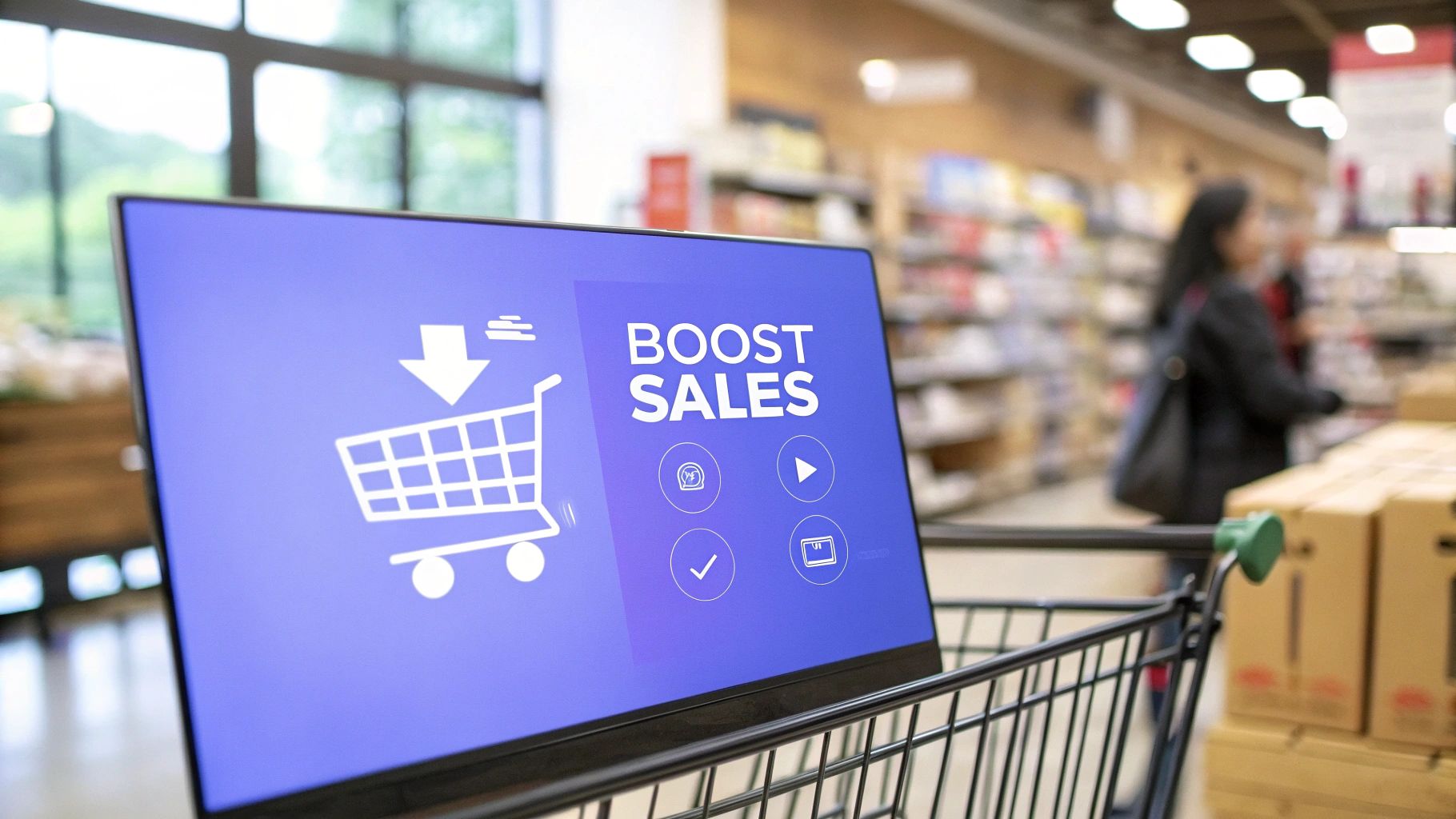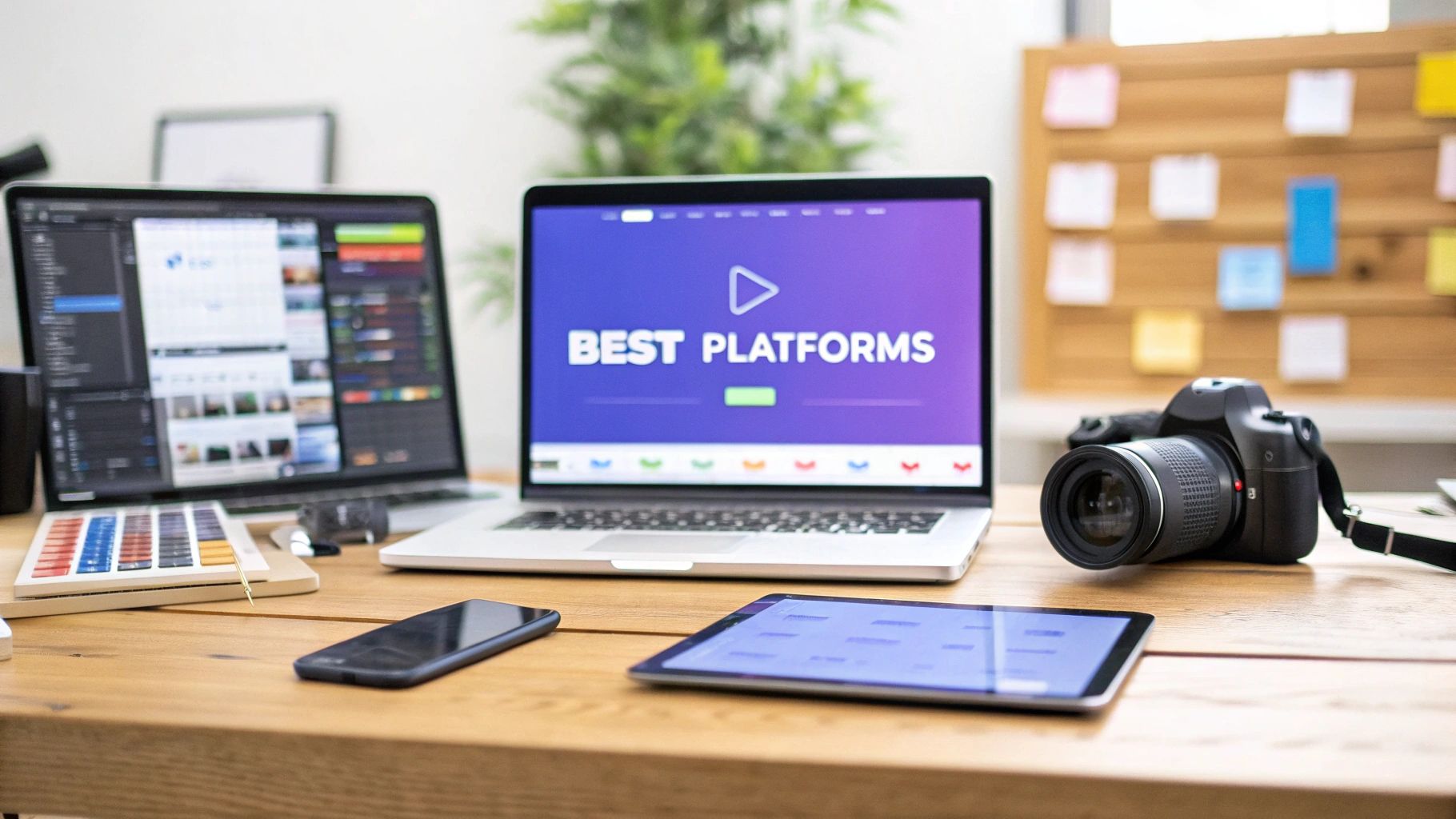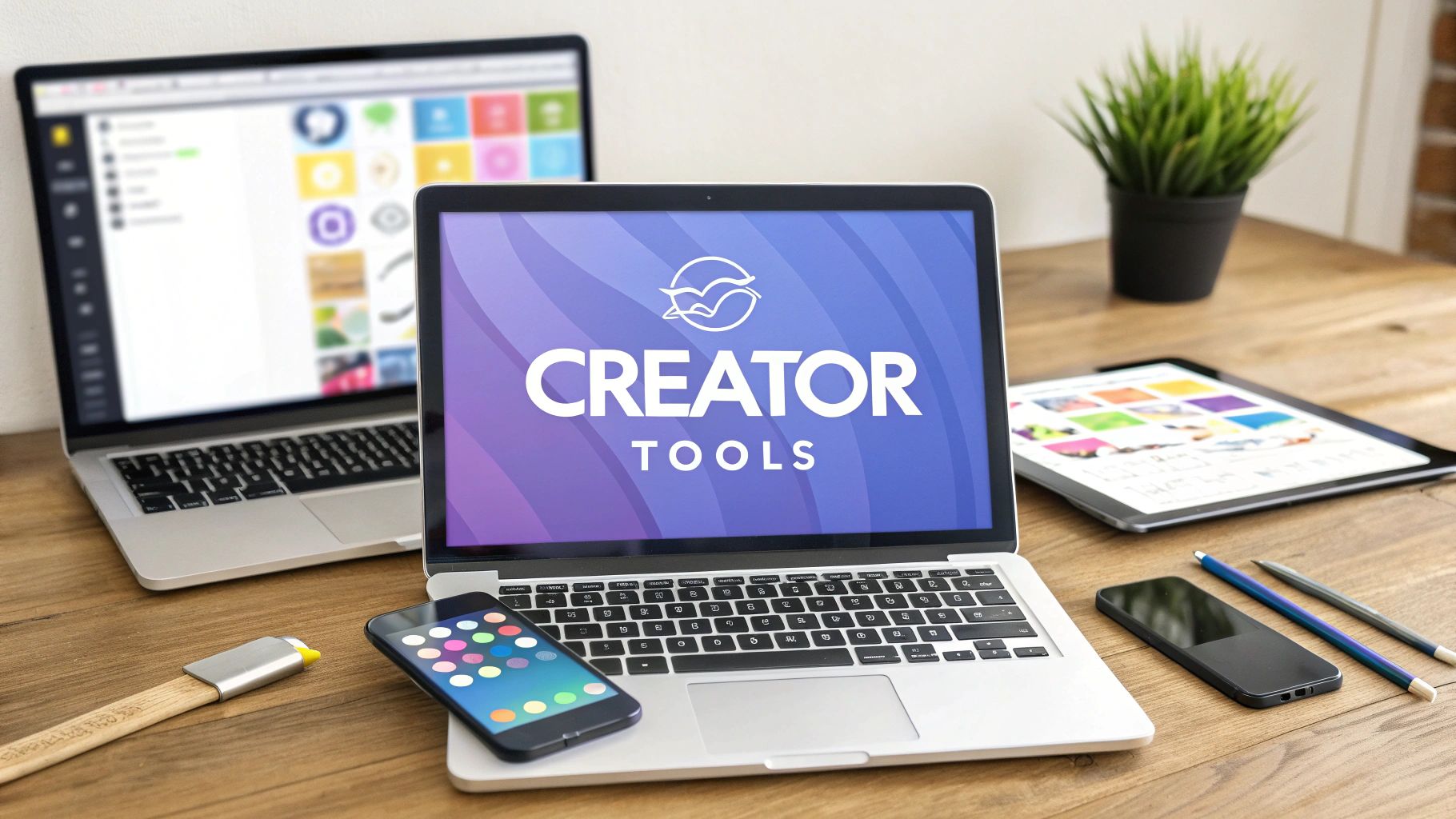Lights, Camera, Conversions!
Want to boost your online sales with video? This listicle reveals seven powerful ecommerce video ad types to capture attention and drive conversions. Learn how user-generated content, product demos, shoppable videos, and more can elevate your brand and increase your bottom line. From short, snappy social media clips to engaging live shopping events, discover the video strategies that are transforming ecommerce marketing.
1. User-Generated Content (UGC) Video Ads
In the dynamic world of ecommerce, video ads reign supreme. Among the most effective types of video ads are those featuring User-Generated Content (UGC). UGC video ads leverage authentic content created by real customers showcasing products in their natural environment. These videos often feature genuine testimonials, unboxings, reviews, or demonstrations, all created by actual users rather than professional actors or polished studio productions. This inherent authenticity provides social proof and builds trust, resonating deeply with potential buyers who are increasingly skeptical of traditional advertising. UGC offers a fresh, relatable perspective that can significantly boost engagement and conversions.
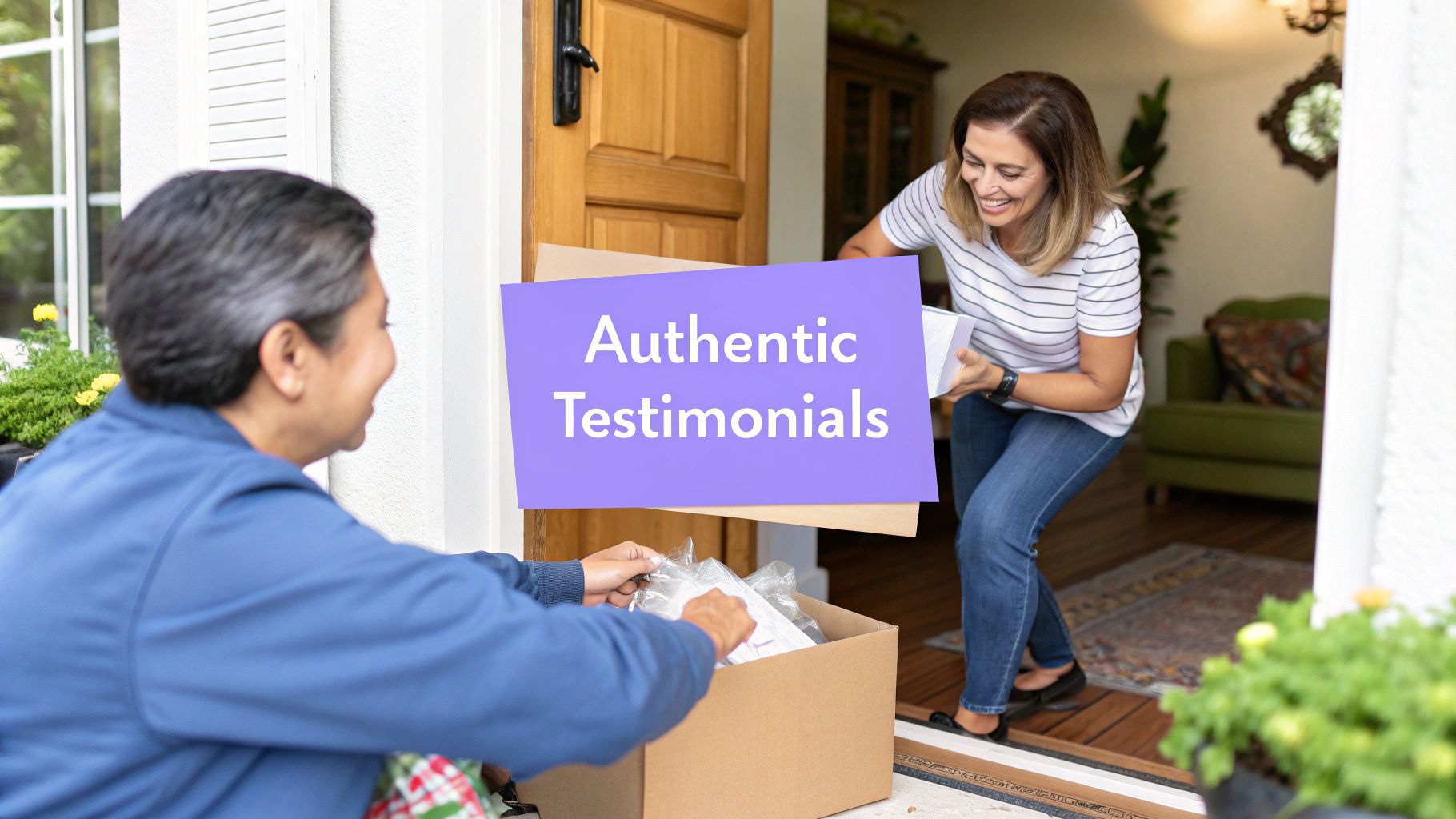
UGC video ads work by tapping into the power of word-of-mouth marketing. When potential customers see real people using and enjoying a product, it creates a sense of trust and relatability that traditional advertising often struggles to achieve. This is particularly effective because it bypasses the polished, sometimes artificial feel of professional marketing, offering a glimpse into how the product fits into everyday life. This organic approach makes the benefits of the product feel more tangible and achievable for the viewer.
The success of UGC video ads is well-documented. GoPro, for example, has built a massive following by showcasing customer-created adventure videos, generating millions of views and cementing the brand's image as synonymous with action and excitement. Similarly, Glossier's customer makeup tutorials on Instagram provide practical demonstrations and inspire potential buyers with diverse beauty looks. Daniel Wellington expertly utilizes influencer-generated content, turning stylish watch photos into engaging video compilations. And Airbnb invites travelers to share their unique experiences, showcasing the platform's diverse range of accommodations through authentic guest videos.
This approach offers a number of key advantages. UGC video ads boast higher trust and credibility than traditional advertisements, leading to better conversion rates due to the inherent social proof. They are also significantly lower in production costs compared to professionally produced videos, making them an incredibly cost-effective content creation strategy, particularly appealing to small businesses and startups. Furthermore, the diverse range of creators and perspectives inherent in UGC content allows for scalable content generation and can foster increased brand loyalty from featured customers who feel valued and appreciated by the brand.
However, utilizing UGC does come with its own set of challenges. Brands have less control over messaging and the overall quality of the content compared to professionally produced material. There's also the potential for negative or off-brand content to surface, requiring careful curation. Legal considerations regarding usage rights are crucial, and obtaining proper permissions is essential. The curation process itself can be time-intensive, requiring dedicated resources to sift through submissions and ensure they align with brand guidelines. Finally, maintaining consistent quality standards across a range of user-generated content can be difficult.
To maximize the effectiveness of UGC video ads, consider these actionable tips: Create clear guidelines for UGC creators, outlining desired content themes, video length, and brand messaging. Offer incentives like discounts or features on the company’s social media channels for high-quality content submissions. Leverage hashtag campaigns to encourage wider participation and easier content discovery. Always obtain proper permissions before using any user-generated content, protecting both your brand and the creator. Finally, dedicate time to carefully curate content, selecting videos that genuinely align with your brand values and maintain acceptable quality standards.
UGC video ads are a powerful tool in any ecommerce marketing arsenal. They are particularly valuable for businesses seeking to build trust, boost engagement, and drive conversions. By understanding the nuances of UGC and implementing these strategies, businesses of all sizes can harness the power of authentic customer voices to achieve significant marketing success. Learn more about User-Generated Content (UGC) Video Ads and how it intersects with influencer marketing, a closely related strategy. This approach deserves its place on any list of effective ecommerce video ad strategies because it effectively leverages the power of authenticity and social proof, key drivers in today's consumer landscape.
2. Product Demo and Tutorial Videos
Product demo and tutorial videos are a powerful tool in the arsenal of ecommerce video ads. They go beyond simple product showcases and delve into the practical applications and functionalities of your offerings. By providing step-by-step demonstrations and clear explanations, these videos educate potential customers, build confidence in their purchase decisions, and ultimately drive sales. This approach is particularly effective in the competitive landscape of ecommerce, where informed consumers are more likely to convert. This makes product demo videos a crucial component of any successful ecommerce video ad strategy.
These videos effectively bridge the gap between seeing a product online and understanding its value in a real-world context. Think about it: a static image can only convey so much. A product demo video, on the other hand, can show a customer exactly how a complex gadget works, demonstrate the ease of using a new kitchen appliance, or illustrate the transformative power of a beauty product. This visual learning experience empowers customers with the knowledge they need to make informed decisions, reducing purchase hesitation and ultimately increasing conversions.
For instance, imagine you're selling a high-tech blender. A simple product photo might show its sleek design, but a demo video can showcase its multiple speed settings, its ability to crush ice, its self-cleaning function, and even its quiet operation. Suddenly, the customer understands the blender's full potential and is more likely to add it to their cart.
Here’s a breakdown of the key features that make product demo and tutorial videos so compelling:
- Step-by-step demonstrations: Clear, concise instructions that guide the viewer through the product's usage.
- Feature explanations: Highlighting the key benefits and functionalities of the product in a digestible format.
- Problem-solving focus: Positioning the product as a solution to specific customer pain points.
- Before and after comparisons: Visually demonstrating the product's effectiveness and impact.
- Multiple use case scenarios: Showcasing the product's versatility and applicability in different situations.
The benefits of incorporating product demo and tutorial videos into your ecommerce video ads are substantial:
Pros:
- Reduces product return rates: By providing a clear understanding of the product’s functionalities, customers are less likely to be disappointed and return the product.
- Increases customer confidence: Informed customers are more likely to feel confident in their purchase decisions.
- Provides clear value proposition: Clearly articulates the benefits and value the product offers to the customer.
- Repurposing across platforms: These videos can be used on product pages, social media, email marketing campaigns, and more.
- SEO and organic discovery boost: Videos can improve your website’s SEO and increase organic visibility.
Cons:
- Requires detailed product knowledge: Creating effective demos requires a thorough understanding of the product.
- Can become outdated: Product updates may require recreating videos to reflect new features or functionalities.
- Higher production complexity: Creating high-quality demo videos can be more time-consuming and resource-intensive than other video formats.
- May reveal product limitations: Honest demonstrations might inadvertently highlight certain product limitations.
- Time-intensive: Creating compelling, high-quality demo videos takes time and effort.
Numerous brands have successfully leveraged product demo and tutorial videos. Dyson, for example, uses dynamic demonstrations to showcase the powerful suction of their vacuum cleaners. Instant Pot provides recipe and cooking tutorials that highlight the versatility of their pressure cookers. Sephora creates engaging makeup application tutorials using their products. Even tech giants like Apple utilize product demos to unveil new features and functionalities.
Here are some actionable tips for creating effective product demo and tutorial videos:
- Focus on solving customer pain points: Address the specific challenges your target audience faces.
- Keep it concise: While comprehensive, avoid unnecessarily long videos. Respect your viewers’ time.
- High-quality visuals and audio: Invest in good lighting, clear audio, and professional editing.
- Include captions for accessibility: Make your videos accessible to a wider audience.
- Clear call-to-action: Guide viewers towards the next step, whether it's visiting your website or making a purchase.
Learn more about Product Demo and Tutorial Videos
By understanding the nuances of product demo and tutorial videos, you can effectively leverage this powerful format to boost your ecommerce video ad strategy and drive significant results. These videos are particularly relevant for complex products, innovative solutions, or items requiring specific instructions. By showcasing the practical applications and benefits of your product, you can empower potential customers with the knowledge they need to make informed purchase decisions and ultimately, choose your brand.
3. Shoppable Video Ads
Shoppable video ads represent a significant evolution in e-commerce marketing, blurring the lines between entertainment and purchasing. They seamlessly integrate direct purchasing capabilities within the video content itself, allowing viewers to click on products featured in the video and complete their purchases without ever leaving the video platform. This streamlined approach dramatically reduces friction in the customer journey, transforming passive viewers into active buyers. Imagine watching a product demonstration video and being able to buy the featured product with just a few taps – that's the power of shoppable video ads. This innovative format combines the engaging nature of video content with the immediacy of online shopping, creating a powerful tool for boosting sales and brand engagement.
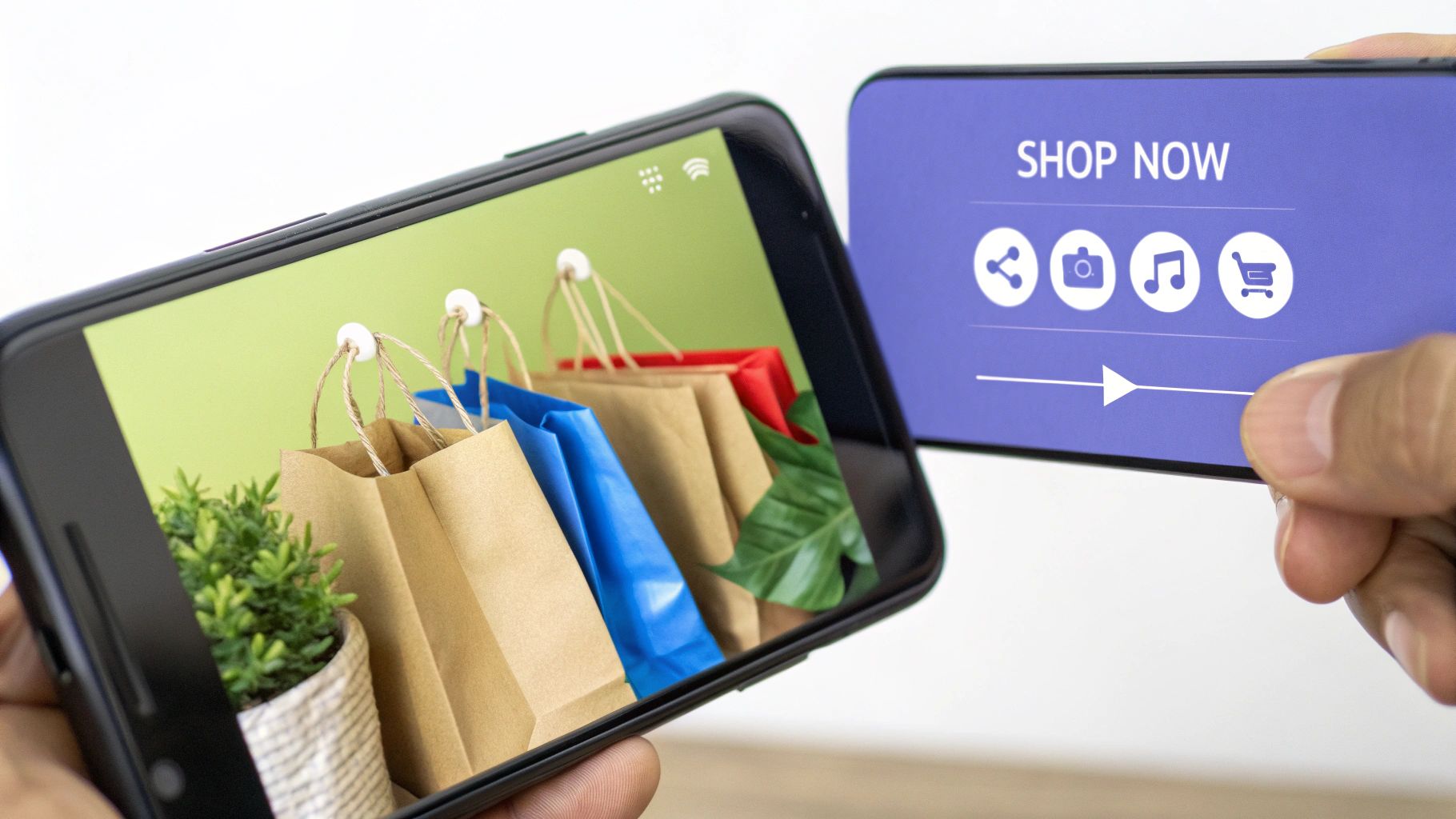
Shoppable videos work by embedding clickable product tags directly within the video player. These tags, often appearing as small icons or overlays, link directly to product pages where viewers can learn more and complete their purchase. Integrated checkout processes further enhance the experience, allowing customers to finalize transactions without navigating away from the video platform. Real-time inventory display ensures accurate product availability information is presented to the viewer, preventing frustration and lost sales. The ability to showcase multiple products within a single video allows brands to highlight a range of offerings and cater to diverse customer preferences. This creates a platform-native shopping experience that feels natural and intuitive for the user.
Several platforms have embraced shoppable video ads, offering unique features and functionalities. Instagram Shopping ads utilize product tags within Stories and Reels, allowing viewers to tap and purchase featured items. YouTube's Shopping ads showcase product shelves below the video, providing easy access to featured products. TikTok Shopping ads offer a direct checkout experience, further streamlining the purchase process. Facebook's Collection ads provide an "instant experience," immersing viewers in a full-screen mobile shopping experience directly from the ad.
The benefits of shoppable video ads are numerous. They significantly reduce purchase friction, leading to higher conversion rates, especially for impulse buys spurred by engaging video content. Improved ROI tracking and attribution provide valuable insights into campaign performance. The seamless user experience fosters positive brand perception and encourages repeat purchases. By allowing real-time purchasing decisions, these ads capitalize on viewer engagement and minimize the chance of losing potential customers.
However, shoppable video ads also come with certain drawbacks. Platform dependency and limitations can restrict creative freedom and reach. Technical complexity in implementation may require specialized skills or third-party tools. Higher setup costs compared to traditional video ads can be a barrier for smaller businesses. Limited customization options on some platforms can hinder branding efforts. Furthermore, successful implementation requires seamless integration with existing inventory management systems.
When and why should you use shoppable video ads?
Consider this approach if your goal is to:
- Boost direct sales: Shoppable videos directly link engagement with purchase opportunities.
- Reduce cart abandonment: The streamlined checkout process minimizes steps and encourages completion.
- Improve ROI: Better tracking and attribution capabilities provide valuable data for optimization.
- Enhance brand engagement: The interactive format fosters deeper connections with viewers.
- Reach mobile-first audiences: Shoppable videos are optimized for mobile devices and cater to on-the-go shoppers.
Tips for success with shoppable video ads:
- Ensure mobile optimization: Prioritize touch-friendly interfaces and seamless mobile navigation.
- Test different product tag placements: Experiment with various positions and timings to optimize click-through rates.
- Keep inventory updated in real-time: Avoid customer frustration by ensuring accurate product availability.
- Use high-quality product images for tags: Visually appealing product representations enhance the shopping experience.
- Optimize for platform-specific shopping features: Leverage unique platform functionalities to maximize impact.
Shoppable video ads represent a powerful addition to any e-commerce marketing strategy. By understanding their functionalities, benefits, and limitations, businesses can effectively leverage this innovative format to drive sales, enhance brand engagement, and stay ahead of the curve in the ever-evolving world of online retail.
4. Story-Driven Brand Videos
In the competitive landscape of ecommerce, grabbing attention and fostering genuine connections with your audience is paramount. While direct product-focused ecommerce video ads can be effective for driving immediate sales, story-driven brand videos offer a powerful way to cultivate long-term brand loyalty and emotional engagement. These videos leverage compelling narratives to resonate with your target customers' values, aspirations, and experiences, subtly weaving your products into the storyline. This approach prioritizes building a relationship with your audience rather than simply pushing a sale, making it a valuable addition to your ecommerce video ads strategy.
Story-driven brand videos work by tapping into the emotional core of your target audience. Instead of explicitly highlighting product features and benefits, they focus on creating a memorable and relatable experience. By presenting your products within the context of a captivating story, you create a positive association between your brand and the emotions evoked by the narrative. This resonates more deeply with viewers than a traditional sales pitch, leading to increased brand recall, stronger emotional connections, and ultimately, greater customer loyalty.
Features of Effective Story-Driven Brand Videos:
- Narrative-focused content structure: The story is the central focus, driving the video's flow and capturing the audience's attention.
- Emotional storytelling elements: Joy, sadness, humor, inspiration – these elements create a connection and make the story memorable.
- Character development and journey: Compelling characters that the audience can relate to and follow on their journey strengthen engagement.
- Brand values integration: Seamlessly weaving brand values into the narrative reinforces what your brand stands for.
- Cinematic production quality: High-quality visuals and sound design elevate the storytelling and enhance the viewer experience.
Pros:
- Creates strong emotional brand connections: Stories evoke empathy and build a stronger bond with your audience.
- Increases brand recall and recognition: Memorable narratives stick with viewers long after the video ends.
- Differentiates from competitors: In a sea of product-focused ads, story-driven videos stand out.
- Builds long-term customer loyalty: Emotional connections foster loyalty and repeat purchases.
- Often achieves viral potential: Engaging stories have a higher chance of being shared, expanding your reach organically.
Cons:
- Higher production costs and complexity: Crafting compelling narratives and high-quality visuals requires investment.
- Longer time to see direct ROI: Brand building is a long-term strategy, so immediate sales may not be the primary metric.
- Risk of message being overshadowed by story: Ensure the product integration is subtle yet effective.
- Requires strong creative expertise: Developing compelling narratives and executing them effectively requires skilled storytellers and filmmakers.
- May not drive immediate conversions: This approach focuses on brand building rather than immediate sales.
Examples of Successful Story-Driven Ecommerce Video Ads:
- Nike's 'Just Do It' athlete journey campaigns: These videos showcase athletes overcoming challenges and achieving their goals, inspiring viewers and reinforcing Nike's brand message of empowerment.
- Dove's 'Real Beauty' self-acceptance stories: Dove's campaigns focus on promoting positive body image and self-esteem, creating an emotional connection with their target audience.
- Apple's lifestyle integration narratives: Apple's ads often depict how their products seamlessly integrate into everyday life, showcasing the aspirational lifestyle associated with the brand.
- Patagonia's environmental activism stories: Patagonia uses storytelling to highlight their commitment to environmental conservation, resonating with environmentally conscious consumers.
Tips for Creating Effective Story-Driven Ecommerce Video Ads:
- Align stories with brand values authentically: Ensure the story reflects your brand's core beliefs and mission.
- Focus on customer emotions and aspirations: Understand your target audience and what resonates with them emotionally.
- Keep product integration natural and subtle: Don't force the product into the story; let it flow naturally within the narrative.
- Invest in high-quality production values: High-quality visuals and sound enhance the storytelling and create a more immersive experience.
- Test story concepts with target audiences: Get feedback before launching your campaign to ensure the story resonates.
When and Why to Use Story-Driven Brand Videos:
Story-driven brand videos are ideal for ecommerce businesses looking to build long-term brand equity and foster deeper connections with their audience. This approach is particularly effective for brands with strong values and a desire to differentiate themselves from competitors. While it may not drive immediate conversions, it builds a foundation for sustained growth and customer loyalty. If your goal is to establish a strong brand presence, build emotional connections, and create a community around your brand, then incorporating story-driven videos into your ecommerce video ads strategy is a powerful way to achieve those objectives. It is a valuable investment in the long-term success of your brand.
This approach has been popularized by brands like Nike, Dove, Apple, and Coca-Cola, demonstrating its effectiveness in building strong brand identities and cultivating loyal customer bases. By focusing on the emotional connection with consumers, story-driven videos offer a compelling alternative to traditional product-focused advertising in the ecommerce landscape.
5. Short-Form Social Video Ads
In today's fast-paced digital world, capturing attention quickly is crucial for successful ecommerce video ads. Short-form social video ads have emerged as a powerful tool for achieving this, offering a dynamic and engaging way to connect with potential customers on platforms they frequent the most. These bite-sized videos, optimized for platforms like TikTok, Instagram Reels, and YouTube Shorts, leverage trending formats and mobile-first consumption to deliver impactful brand messaging with high shareability potential. They are a must-have in any comprehensive ecommerce video ad strategy.
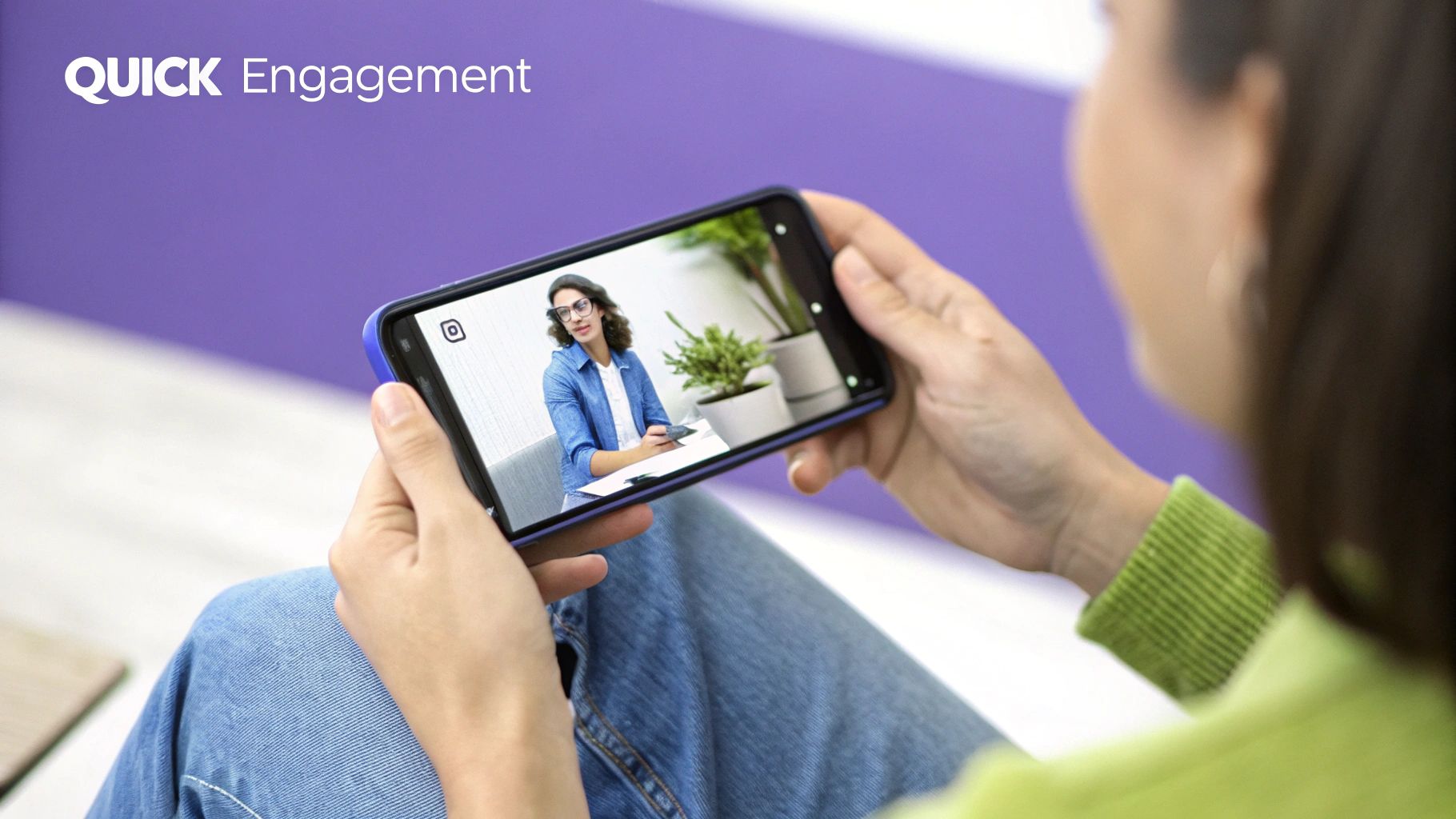
Typically ranging from 15 to 60 seconds, short-form social video ads are designed to make an immediate impact. They embrace vertical or square video formats, seamlessly integrating trending music and effects, and adopting platform-specific editing styles for a native feel. This mobile-optimized viewing experience caters to the way audiences consume content today – quickly and on the go. The concise nature of these ads demands a focus on impactful visuals, catchy audio, and clear, concise messaging, making them highly effective in grabbing attention within the limited timeframe. Learn more about Short-Form Social Video Ads for a deeper understanding of their rapid creation and deployment.
Several brands have successfully leveraged short-form video ads for their ecommerce marketing. Ocean Spray's viral TikTok video featuring a man skateboarding while drinking cranberry juice, set to Fleetwood Mac's "Dreams," is a prime example of the organic reach and engagement these ads can achieve. Similarly, Chipotle's TikTok challenge videos have generated massive user participation, driving brand awareness and engagement. Gymshark effectively uses short-form fitness transformation videos to showcase their products and inspire their target audience, while Fenty Beauty utilizes quick makeup tutorials to highlight product usage and drive sales. These examples demonstrate the versatility and effectiveness of short-form video ads across various industries.
When and why should you use this approach for your ecommerce video ads? Short-form video ads are particularly effective when targeting younger demographics who are heavily active on social media platforms. They are ideal for promoting new products, running limited-time offers, driving traffic to your website, and building brand awareness. The cost-effective production requirements make them accessible to businesses of all sizes, offering a high return on investment potential. Furthermore, the ability to quickly iterate and test different variations allows for continuous optimization and refinement of your ad campaigns based on real-time performance data.
While the benefits are numerous, it’s important to be aware of the potential drawbacks. The limited timeframe can make conveying complex messages challenging. The highly competitive content environment on these platforms requires constant trend monitoring and creative adaptation to stand out. Algorithm dependency can also impact reach and visibility. Finally, the short content lifespan means you need to consistently produce fresh content to maintain engagement.
To maximize the effectiveness of your short-form social video ads, consider these tips:
- Hook viewers in the first 3 seconds: With limited time, capturing attention immediately is paramount.
- Use trending sounds and hashtags strategically: This can increase discoverability and engagement.
- Keep branding subtle but recognizable: Integrate your brand elements seamlessly without being overly intrusive.
- Optimize for sound-off viewing with captions: Many users browse social media with the sound off, so captions are crucial for conveying your message.
- Test multiple variations quickly: Experiment with different creative approaches to identify what resonates best with your target audience.
Short-form social video ads deserve their place in any modern ecommerce marketing strategy. Their ability to capture attention quickly, leverage trending formats, and reach a highly engaged mobile audience makes them a powerful tool for driving brand awareness, engagement, and ultimately, sales. By understanding the features, benefits, and best practices, businesses can harness the potential of these dynamic ads to achieve their ecommerce objectives.
6. Retargeting Video Sequences
Retargeting video sequences represent a powerful tool in the arsenal of ecommerce video ads. They move beyond simple retargeting by showing different video ads to users based on their previous interactions with your brand. Instead of a single generic ad, retargeting video sequences create a progressive narrative that guides prospects through the sales funnel, ultimately increasing the likelihood of conversion. This personalized approach is a significant step up from traditional advertising methods and makes this strategy deserve its place amongst the top tactics for ecommerce video ads.
This approach works by tracking user behavior on your website or app and then delivering tailored video content based on that behavior. For example, if a user viewed a specific product page but didn't add the product to their cart, they might be shown a video ad highlighting the product's features and benefits. If they added the product to their cart but abandoned the checkout process, they might see a video ad offering a discount or free shipping. This sequential messaging, personalized to the user's journey, significantly increases the effectiveness of your video ads.
Retargeting video sequences offer several key features, including sequential messaging based on user behavior, personalized content delivery, funnel-stage specific videos, cross-platform retargeting capabilities, and automated sequence triggering. This allows for a highly targeted and efficient advertising strategy.
Benefits of Using Retargeting Video Sequences:
- Higher Conversion Rates Through Personalization: By delivering relevant content at each stage of the funnel, you dramatically increase the chances of a user converting.
- Better ROI on Advertising Spend: Targeting users who have already shown interest in your brand leads to more efficient use of your advertising budget.
- Reduced Ad Fatigue Through Varied Content: Showing a sequence of different videos keeps users engaged and prevents them from tuning out your message.
- Improved Customer Journey Optimization: By analyzing user behavior and adjusting your video sequences accordingly, you can continually refine the customer journey.
- Enhanced Brand Recall Through Repetition: Repeated exposure to your brand, through different video ads, reinforces your message and improves brand recognition.
Challenges of Implementing Retargeting Video Sequences:
- Requires Sophisticated Tracking Setup: Accurately tracking user behavior across different platforms requires a robust tracking system.
- Multiple Video Assets Needed: Creating a sequence of videos requires more upfront investment in content creation.
- Privacy Concerns and Regulations: Adhering to data privacy regulations is crucial when implementing retargeting strategies.
- Complex Campaign Management: Managing multiple video sequences across different platforms can be complex.
- Higher Initial Setup Costs: The initial setup of retargeting video sequences can be more expensive than simpler retargeting campaigns.
Examples of Successful Implementation:
- Amazon: Uses product-specific retargeting videos to remind users of items they viewed or left in their cart.
- Netflix: Employs personalized show recommendation videos based on viewing history.
- Booking.com: Delivers destination-specific follow-up ads after users search for travel destinations.
- Shopify: Utilizes progressive feature introduction sequences to onboard new users.
Actionable Tips for Implementing Retargeting Video Sequences:
- Map Video Content to Specific Funnel Stages: Tailor your video content to address the specific needs and motivations of users at each stage of the sales funnel.
- Set Appropriate Frequency Caps to Avoid Fatigue: Limit the number of times a user sees your videos to prevent ad fatigue.
- Use Dynamic Product Ads for Personalization: Dynamically insert product images and information into your videos to create highly personalized ads.
- Test Different Sequence Lengths and Timings: Experiment with different sequence lengths and timings to optimize your campaigns.
- Ensure Consistent Branding Across All Videos: Maintain a consistent brand identity across all videos in your sequence.
The following infographic illustrates the core process of a retargeting video sequence:
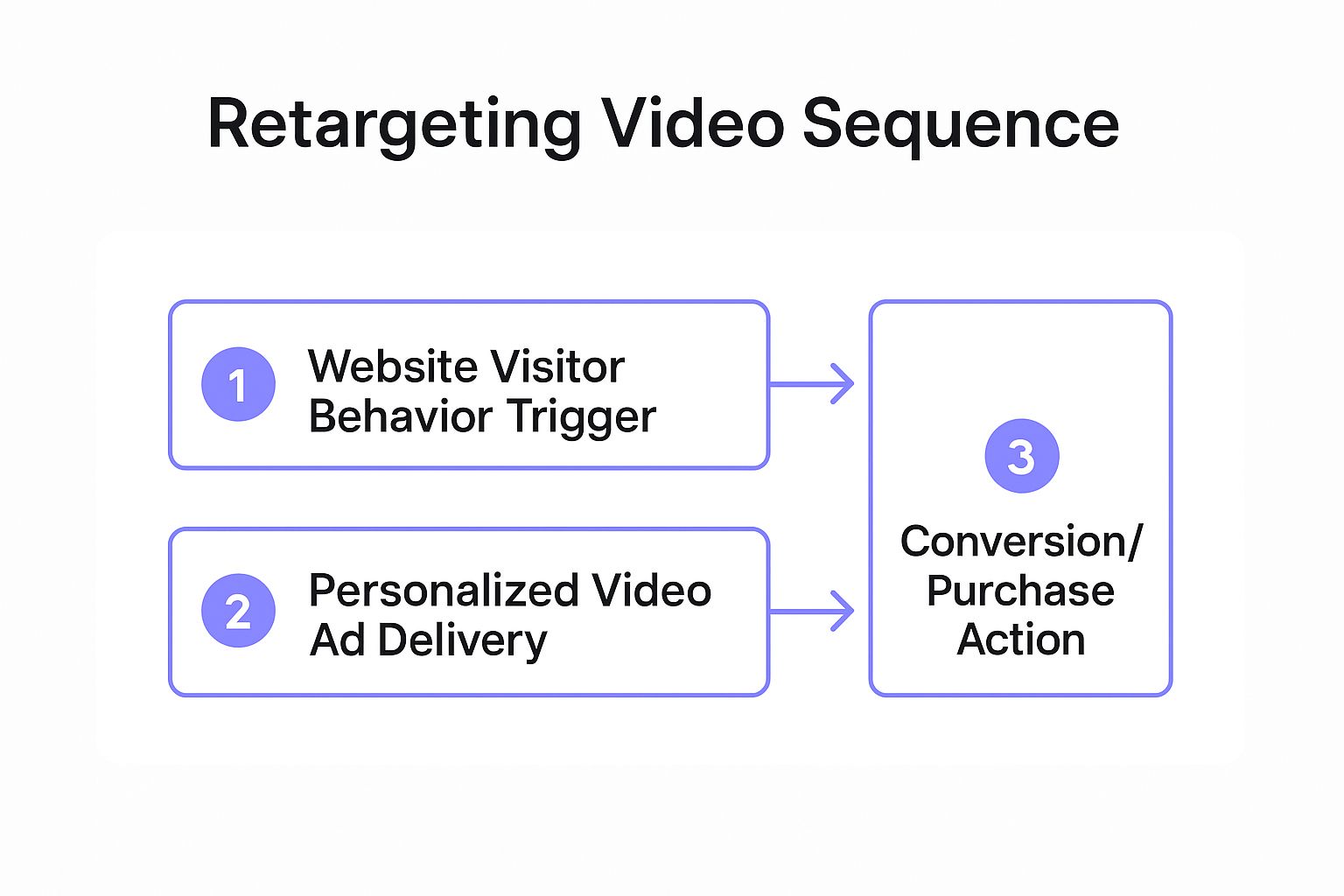
This infographic visualizes the three key stages: 1) Website Visitor Behavior Trigger (e.g., browsing a product page, adding to cart), 2) Personalized Video Ad Delivery (showing a relevant product video), and 3) Conversion/Purchase Action.
The visualization clearly demonstrates the cyclical nature of retargeting video sequences, where user behavior triggers specific video ads, driving them further down the sales funnel towards a purchase. This personalized approach optimizes the customer journey and maximizes the impact of your ecommerce video ads. Retargeting video sequences, while requiring careful planning and execution, are invaluable for boosting conversions and achieving a higher return on your advertising spend. Platforms like Facebook Ads Manager, Google Ads, Amazon DSP, and Adobe Advertising Cloud have popularized and simplified the implementation of such strategies.
7. Live Shopping Video Events
Live shopping video events are revolutionizing the way e-commerce businesses connect with their customers and drive sales. This exciting format combines the immediacy of live streaming with the convenience of online shopping, creating a dynamic and engaging experience that sets it apart from other ecommerce video ads. By leveraging real-time interaction and the power of scarcity, live shopping events offer a unique opportunity to boost conversions and foster brand loyalty. If you're looking for a cutting-edge approach to ecommerce video ads, live shopping is definitely worth exploring.
Essentially, live shopping transforms online shopping into an interactive experience, mimicking the energy and excitement of in-person shopping. A host, often a brand representative, influencer, or subject matter expert, presents products live, demonstrates their features, and answers questions from viewers in real time. Simultaneously, viewers can purchase the featured products directly within the live stream interface, often with exclusive discounts and limited-time offers. This combination of entertainment and instant purchasing creates a sense of urgency and encourages immediate action, making live shopping a highly effective ecommerce video ad strategy.
Several platforms have embraced live shopping, making it accessible to businesses of all sizes. Examples of successful implementations include:
- QVC's digital transformation: QVC, a pioneer of televised shopping, has successfully adapted its model for the digital age, offering live shopping experiences on its website and app. This demonstrates the longevity and adaptability of the format.
- Instagram Live Shopping: Fashion and beauty brands frequently utilize Instagram Live Shopping to showcase new collections, offer styling tips, and interact directly with their followers. This platform’s visual nature makes it ideal for showcasing products.
- Facebook Live shopping demonstrations: Businesses leverage Facebook Live to host product demonstrations, tutorials, and Q&A sessions, allowing them to connect with their existing audience and reach new potential customers.
- TikTok Live Shopping sessions: Known for its short-form video content, TikTok has also embraced live shopping, particularly among beauty and lifestyle brands, appealing to a younger demographic.
The advantages of incorporating live shopping into your ecommerce video ads strategy are numerous:
- Creates urgency and immediate action: Limited-time offers and the fear of missing out (FOMO) encourage viewers to purchase immediately.
- Builds authentic brand relationships: The interactive nature of live shopping allows brands to connect with their customers on a personal level, fostering trust and loyalty.
- Higher engagement than pre-recorded content: Live events offer a more dynamic and engaging experience than traditional pre-recorded videos.
- Real-time feedback and adaptation: Brands can gather immediate feedback from their audience and adjust their presentations accordingly.
- Community building opportunities: Live shopping events create a sense of community among viewers, fostering a shared experience around a brand or product.
However, it's crucial to be aware of the challenges associated with live shopping:
- Requires significant planning and coordination: Successful live shopping events require careful planning, including product selection, script development, and technical setup.
- Risk of technical issues during live events: Internet connectivity problems or equipment malfunctions can disrupt the flow of a live event.
- Time-zone limitations for global audiences: Choosing optimal broadcast times can be challenging when targeting a global audience across multiple time zones.
- Need for charismatic and knowledgeable hosts: A skilled and engaging host is essential to keep viewers entertained and informed.
- Cannot edit or perfect content post-production: Unlike pre-recorded videos, live events cannot be edited after the fact, so thorough preparation is crucial.
To maximize the effectiveness of your live shopping ecommerce video ads, consider the following tips:
- Prepare thoroughly with product knowledge and demos: Ensure your host is well-versed in the product features and benefits and has prepared compelling demonstrations.
- Test technical setup extensively before going live: Thorough testing minimizes the risk of technical glitches during the live event.
- Engage actively with audience comments and questions: Respond to viewer questions and comments promptly and enthusiastically to foster engagement.
- Offer exclusive live-only deals to drive urgency: Incentivize purchases by offering special discounts and promotions available only during the live event.
- Promote events in advance across all channels: Build anticipation and maximize viewership by promoting your live shopping event across your website, social media platforms, and email list.
By understanding the nuances of live shopping and implementing these best practices, you can leverage this powerful tool to create highly engaging ecommerce video ads that drive conversions and build lasting customer relationships.
7 Ecommerce Video Ad Strategies Compared
| Strategy | Implementation Complexity 🔄 | Resource Requirements ⚡ | Expected Outcomes 📊 | Ideal Use Cases 💡 | Key Advantages ⭐ |
|---|---|---|---|---|---|
| User-Generated Content (UGC) Video Ads | Medium 🔄🔄 | Low ⚡⚡ | High engagement and conversion 📊📊 | Brands seeking authenticity and social proof 💡 | High trust and low cost ⭐⭐ |
| Product Demo and Tutorial Videos | High 🔄🔄🔄 | Medium-High ⚡⚡⚡ | Increased purchase confidence and reduced returns 📊📊 | Educating customers on product use 💡 | Clear value demonstration and SEO benefits ⭐⭐ |
| Shoppable Video Ads | Very High 🔄🔄🔄🔄 | High ⚡⚡⚡⚡ | Higher conversion rates and seamless shopping 📊📊 | E-commerce needing frictionless purchases 💡 | Direct purchase from video, better ROI tracking ⭐⭐ |
| Story-Driven Brand Videos | High 🔄🔄🔄 | High ⚡⚡⚡ | Strong brand loyalty and emotional engagement 📊📊 | Building long-term brand equity and emotional connection 💡 | Deep emotional connection and differentiation ⭐⭐ |
| Short-Form Social Video Ads | Low-Medium 🔄🔄 | Low ⚡⚡ | Quick engagement and viral reach 📊 | Mobile-first social campaigns targeting younger audience 💡 | Fast production and high shareability ⭐⭐ |
| Retargeting Video Sequences | Very High 🔄🔄🔄🔄 | High ⚡⚡⚡⚡ | Higher conversions through personalization 📊📊 | Driving conversions with personalized funnels 💡 | Personalized targeting and improved ROI ⭐⭐⭐ |
| Live Shopping Video Events | Very High 🔄🔄🔄🔄 | High ⚡⚡⚡⚡ | Immediate sales and community building 📊📊 | Real-time interaction and urgency-driven sales 💡 | Urgency and direct engagement with audience ⭐⭐ |
Level Up Your Ecommerce Strategy
From user-generated content and shoppable videos to live streams and retargeting campaigns, this article has explored a diverse range of ecommerce video ad formats. We’ve seen how powerful product demos and tutorials can be, the engaging nature of storytelling through video, and the effectiveness of short, snappy social media clips. The key takeaway? Leveraging the right mix of ecommerce video ads is crucial for staying competitive and capturing your audience's attention in today's digital landscape.
Mastering these approaches can transform your online store. By implementing the strategies outlined above, you can significantly enhance brand visibility, drive higher conversion rates, and build deeper connections with your customers. Ultimately, embracing the power of ecommerce video ads fuels growth and establishes a lasting presence in your market.
So, are you ready to elevate your ecommerce video ad game? Streamline your video creation and publishing workflow with Sprello, an AI-powered video marketing platform designed to help you maximize your video ROI. Visit Sprello today to explore how Sprello can empower your ecommerce video ad strategy.
